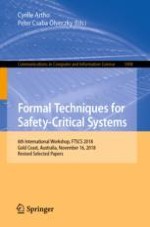2019 | Book
Formal Techniques for Safety-Critical Systems
6th International Workshop, FTSCS 2018, Gold Coast, Australia, November 16, 2018, Revised Selected Papers
Editors: Cyrille Artho, Peter Csaba Ölveczky
Publisher: Springer International Publishing
Book Series : Communications in Computer and Information Science




